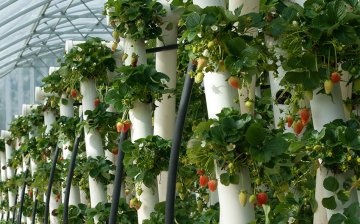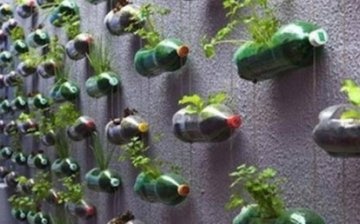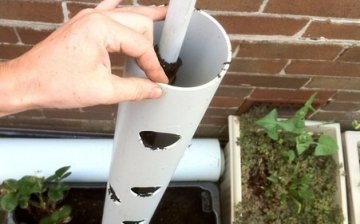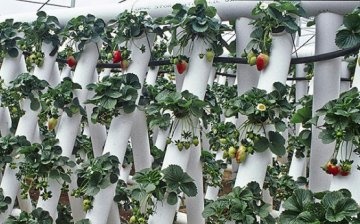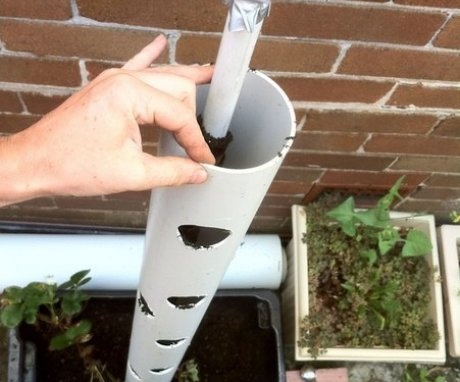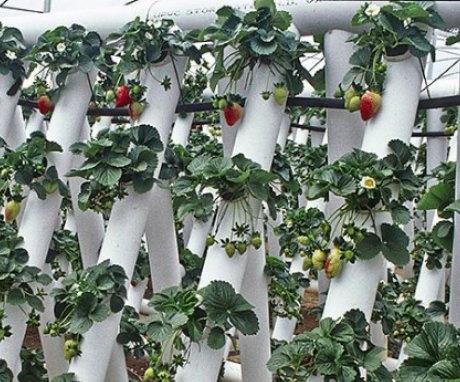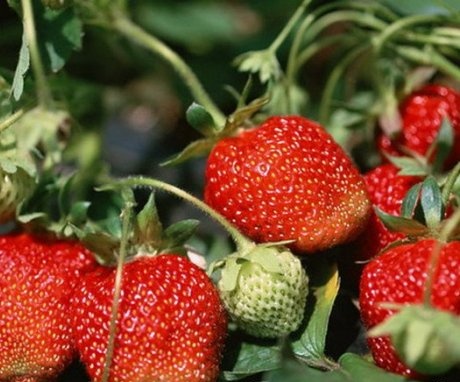How to make vertical strawberry beds with your own hands
It is difficult to place all the desired crops on a small plot of land, so the idea to use the third dimension - height - appeared a long time ago. Vertical beds will give the opportunity to erect structures of almost any area, and at the same time they will be very convenient for use. Initially, such beds were used mainly for growing flowers, but the idea was quickly picked up by summer residents, and now such beds are actively used in growing strawberries. How to make vertical strawberry beds with your own hands?
Content:
- Advantages and disadvantages of the vertical arrangement of the beds
- Options for creating vertical beds
- Create a vertical pipe bed
- Create a vertical bed from drainpipes
- Vertical bed type "Pocket Garden"
Advantages and disadvantages of the vertical arrangement of the beds
To many gardeners, the idea of arranging the beds not on the ground, but on vertical structures still seems exotic, and not everyone dares to experiment with such structures.
At the same time, vertical beds are successfully proving their effectiveness, and in many respects they will be even more convenient than the usual plantings:
- It is easier to work with them than with the usual beds on the ground: you do not have to bend down, the plants can be positioned at a comfortable height in order to minimize the load on the back and arms while caring for the plants.
- They make it possible to save space: if you arrange the beds vertically, then flowers or any other crops can be planted in the vacant space.
- The "vertical vegetable garden" is less in contact with the ground, which reduces the risk of root rot, in addition, the plants will be less susceptible to fungal diseases and pests. Plus, there will be much less weeds, so you can spend less time weeding.
- During a cold snap, such structures can be temporarily transferred to a greenhouse or sheltered from the weather in outbuildings. In warm weather, you can put vertical beds along the fence, they will serve as an additional decorative element.
With all the advantages, such designs have several disadvantages, which should also not be forgotten. Vertical beds you need to feed more often, since due to the small amount of soil, the soil is depleted faster.
In addition, the beds will dry out much faster, so they will need constant, regular watering.
The soil can be further diluted with a hydrogel capable of retaining moisture. As a result, vertical beds will be a good way to save space, but you will need to care for them no less than for regular plantings.
Options for creating vertical beds
To create a vertical bed on the site is within the power of every gardener, and there are dozens of options and varieties of such designs. The general idea is one: several containers with nutritious garden soil are located one above the other, and the entire structure must be placed in the sun if it is planned to grow berry crops such as strawberries and strawberries.
The more containers there are, the more mono plants will be planted, respectively, the yield will change. The height of the structure is limited only by the desire of the gardener, but it is important that the containers do not block the sunlight
Some of the most common options for creating vertical beds:
- The easiest option is ready-made containers, which can be purchased at a flower shop. They are installed on a rack-support one above the other, the support can be placed on the sunny side near the house. If it is planned to create a massive structure, it is immediately assembled on site, since it will be problematic to transport it.
- A simple and practical solution is a vertical bed of plastic bottles: they are closed with corks, an oval hole is cut out in the side part and filled with soil. The bottles can then be attached to the mesh fence with wire or nailed to a wooden picket fence in any order. Plants are planted in bottles, after which they need to ensure constant watering.
- Another interesting option is a vertical flower bed. It can be made from simple flower pots filled with soil and a metal pipe as a base. Holes are made in the pots, after which they are alternately put on the frame in an inclined position. This will allow you to build a large garden bed in a very small space.
You can make a vertical bed using bags of their dense material. They are hung on several levels and filled with earth. This is a simple but effective solution.
There are other possibilities creating similar beds... An interesting but time-consuming option is to create a pyramid bed from square boxes of various sizes. The lower one will be the largest in area, each next one will be smaller than the previous one.
The boxes are filled with earth, and seedlings are planted along the edges of each box. As a result, the plants will grow in steps, and the garden itself will look very beautiful.
Most of these schemes do not provide for drip irrigation, therefore, to maintain moisture in the soil, it is advisable to use a hydrogel or constantly monitor the state of the earth.
Create a vertical pipe bed
One of the interesting solutions in creating vertical beds is to create a pipe in the holes of which cultivated plants will grow. It is this option that is optimal for strawberries and strawberries, since it allows each plant to have enough sunny color. To create it, a large amount of materials is not required, so every summer resident will be able to build it. What do you need to create a vertical bed?
The main material for construction is two plastic water pipes of different diameters: one must be thick enough, and soil will be poured into it, the other is intended for irrigation, so it will be inserted inside the first.
In addition, you will need a pipe plug, expanded clay to create a drainage layer, and a soil suitable for growing strawberries. For it, it is recommended to select loamy or sandy loam soil, pH = 5-6. At the same time, strawberries are not particularly demanding on the soil and can grow on almost any nutritious soil.
The construction of a vertical bed is carried out in several main stages:
- It is necessary to drill holes in a thin pipe: there should be as many of them as possible so that water can freely enter the ground along the entire length of the pipe. In this case, the lower 10 centimeters should remain completely intact.
- On the main thick pipe, you need to make markings for seedlings: usually it is placed in three rows so that the back wall can be freely attached to a wall or other support. The holes can be cut in rows or staggered, as long as the plants do not interfere with each other. The diameter of each is about 5 cm.
- A plug must be placed on a large pipe, after which it is installed to the support.
- A thin pipe is wrapped in burlap or other permeable material. This is to ensure that the soil does not clog the holes and does not interfere with the water penetration into the ground. The lower end of the thin pipe must be closed. You can insert a cork into it or wrap it tightly with tape. In any case, water should not freely leave the structure.
- A thin pipe is vertically inserted into a thick one, the lower part must be covered with expanded clay. After that, the soil is poured into it: the nutrient mixture must be mixed with hydrogel and foam: crushed foam particles will not allow the soil to run up and will provide free air circulation. If this is not done, the roots may gradually begin to rot.
- The seedlings are planted through holes in a large pipe. The small pipe is filled with water, after which the seedlings will receive all the conditions for excellent growth.
There may be more than one such design: if you want to get a large harvest of strawberries, you can install several such pipes, if desired, they can be fastened with a common support and positioned obliquely. As a result, you get several full-fledged beds that will delight the owner with an excellent harvest.
Create a vertical bed from drainpipes
If there are unnecessary drainpipes left on the site after repairing the house, they can be given a second life by using them to create multi-level vertical beds. They look beautiful, take up very little space, and can be attached to any kind of support, such as a regular mesh fence. One of the advantages: they can be of any length, it all depends on what kind of pipe cuttings are at hand.
In addition to the drainpipes themselves, you will need fasteners, plugs and metal wire, with which the structure can be installed to the support.
The plugs are put on the pipes from both sides, after which holes are drilled in the plastic and metal fasteners are installed. The resulting containers can be attached to a fence, or can be hung on cables, for example, near a gazebo or a veranda.
Expanded clay is poured at the bottom of the containers, a layer of earth is laid on top of it, and any seedlings are planted. The amount of soil will be sufficient for growing strawberries and many other crops. This design looks nice, but you need to remember that it does not have a solid support. Because of this, it is best to hang it where there will be no strong wind, otherwise the containers may simply turn over.
Vertical bed type "Pocket Garden"
This is another option for creating a green wall, which will be a nice decoration and help save space. A thin foil insulation is used as a material for it: plants will feel comfortable in it, since the shiny surface will reflect too bright sunlight.
It will be quite simple to create a vertical bed:
- It is necessary to measure the double length of the insulation and fold the material in half. Top seam and side seams are sewn to create the look of a large bag.
- A rectangular marking is applied to the insulation: the sizes of the cells should correspond to the sizes of future pockets-pots for plants. The markings need to be sewn along all lines.
- The upper part of each "pocket" is cut, after which you can pour the soil mixed with the hydrogel into them, and plant the plants.
This technique will allow, with minimal costs and very little labor, to create a full-fledged vertical bed in which various crops can be planted. You can hang the "pocket garden" anywhere: on the wall of a house, on a fence, on any outbuilding. The number of pocket beds depends only on the wishes of the owner himself.
The creation of vertical beds is a rather interesting process that will allow you to implement various ideas and create a full-fledged vegetable garden in a small area.
For growing strawberries this is the most suitable option, since the mini-vegetable garden can be placed anywhere, and it will allow you to get a rich harvest every year. Its creation is within the power of even a novice summer resident, and all that is needed for this is simple improvised materials and a little imagination.
More information can be found in the video.



